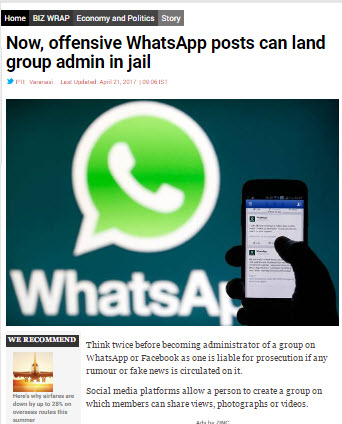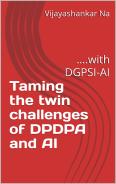When a Palghar girl posted a message on her Facebook raising a query …Why there should be Mumbai Bundh if Mr Bal Thakrey has died? and another Palghar girl clicked on “Like” button against the message, Police in Palghar moved in at the pressure of Shiv Sena activists and perhaps in a bid to prevent a law and order situation arrested the two girls and the Magistrate remanded them to 15 days judicial custody. Unfortunately, the girls belonged to the minority community and media went berserk along with the pseudo secularists. Naturally, it became an issue for national debate culminating in the scrapping of Section 66A of ITA 2000/8 by the Supreme Court.
Unfortunately, the debate was not on the excess committed by the Police in arresting the girls for the innocuous posting on Facebook or liking. The wrath was on the law, more specifically the Section 66A under which the case had been booked and there was the uninformed pseudo intellectuals who wanted the offending law to be scrapped.
Our honourable Courts, both the High Court in Mumbai and subsequently the Supreme Court seemed to agree that there was something wrong with the law, (implying that there was nothing wrong with the Police in interpreting the law) and finally the honourable Supreme Court cited this incident as creating a “Chilling Effect” on the fundamental right of “Freedom of Expression” enshrined in our Constitution and declared that there is no way that this can remain in our law.
There were several brownie points gained by the persons involved in ensuring that Section 66A was scrapped including Police officers, activists, advocates and media persons and even the Judges.
The Government also caved in to the popular perception that Section 66A as it was drafted was at fault and not its interpretation by the Police, prosecutors and the Judges at all levels.
Soon after Section 66A was scrapped, people including the Police, Government and Supreme Court realized that it was a mistake to have scrapped the section and are desperately looking for its reintroduction. A separate expert committee has now been formed to amend ITA 2008 to bring back Section 66A in a face saving manner. The T.K.Vishwanathan Committee is working on this along with other changes that may be required.
In the meantime, WhatsApp has been in the news not only for having been banned in Kashmir for its misuse by Terrorists, but also elsewhere where Admins are being threatened of legal action for offensive messages in a group.
The latest such report comes from Varanasi, according to a joint order issued by the district magistrate of Varanasi and the city’s police chief, FIR can be filed against the Administrator of a WhatsApp group for the posting of an offensive content in the group.
According to the news report, concerns are  often raised about fake news, morphed photos and offensive videos circulated on social media that can potentially trigger tension and even communal strife in a region. To address this, an order has been issued jointly by the Police and Magistrate in Varanasi that an FIR (first investigation report) can be filed against a group administrator if factually incorrect, rumour or misleading information is circulated on his/her social media group.
often raised about fake news, morphed photos and offensive videos circulated on social media that can potentially trigger tension and even communal strife in a region. To address this, an order has been issued jointly by the Police and Magistrate in Varanasi that an FIR (first investigation report) can be filed against a group administrator if factually incorrect, rumour or misleading information is circulated on his/her social media group.
There is no doubt that WhatsApp as well as other messaging solutions and the social media in general can be misused by deviant minds to commit crimes of different sorts including inciting the community.
We take strong objection to the Magistrate and the Police Officer threatening the WhatsApp admins and creating a “Chilling Effect” across the country targeting the WhatsApp admins in general.
We have a law in India called the ITA 2000/8 and the Magistrate and the Police are bound to follow the law and not create their own laws however well intentioned their “order” may be.
Police often give advisories to the public about various crime situations, and an “Advisory” to WhatsApp Admins that they should be careful when adding members to a group to avoid bad elements who try to incite passions and to take counter action if any body is trying to circulate fake news for the purpose of inciting violence in the community.
But an “order” is completely out of place and is ultra vires the law. It must be withdrawn to limit the damage.
In this context it is necessary for us to reiterate that we need to distinguish what is a “Message” and What is “Publishing” and how even the Supreme Court missed this point when they ruled on Section 66A in the Shreya Singhal Case that Section 66A addresses “Free Speech” and makes it punishable.
Notwithstanding the value of this judgement as a “precedent” that can be followed by lower Courts, I would like to state that there is a need to reject this judgement and re-establish a correct understanding of the position of WhatsApp and other messaging systems.
Let me clarify before I am misunderstood that I am completely against the action taken by the Police on the Palghar girls as well as other cases cited in the Shreya Singhal case. But I hold the “Uninformed, ignorant Police” for the plight of innocent citizens and not Section 66A.
Section 66A addressed what we need to recognize as “Messaging” and there are other sections such as Section 67, 67A and 67B which address what we need to recognize as “Publishing”, though the Courts missed this point all together.
Messaging is a communication from one person to another directly with the use of a device such as a mobile phone sending SMS, or E Mail. A message sent to one person is not expected to be available to another person unless the same message is duplicated to the other person in the form of “Group Messages”. “Publishing” on the other hand is a message that is in public domain and is available for any body who is able to access it. Section 66A was meant for messaging and not for publishing. Twitter and Facebook is “Publishing” and not “Messaging” and hence the Supreme Court was wrong in using the Facebook and Twitter cases brought wrongly under Section 66A to scrap Section 66A.
Now in the case of a group message, the law enforcement would be concerned in the case of say a group which meets privately and discusses some criminal activity. Here all the group members have assembled for a common purpose including the Admin who is like the person who organizes a meeting in his house. Though the discussion happens under close doors, if the law enforcement comes to know of the use of a meeting for any anti social activities, it can take action not only against the owner of the house, but also the person who sent out the invites, the person who gave the objectionable speech.
But if a meeting has been organized for some other purpose and some body stands up and shouts say an anti social slogan, then one has to be careful in defining what is the action that the owner of the house where the meeting is taking place and the person who called the meeting and other participants need to take and whether the Police and the Magistrate issue an order that they will be arrested under a charge of organizing the entire event only for the purpose of committing an illegal act.
If so, in the Kannhaiya Kumar case, even the Vice Chancellor of the University and other administrators should be equally guilty.
Police and the Judiciary should recognize that “WhatsApp” is a “Platform” that enables people to send messages from their device to another member’s device. If the addressee is online, the message may reach him immediately. If not, the message would be “in transit” and be delivered to the addressee when he reconnects. In the meantime it is in temporary storage as a “Cache” in the whatsapp server.
WhatsApp is not “Publishing” and the members join voluntarily and are not public. Hence any message exchanged in WhatsApp should be considered as a “Private” communication between two consenting individuals. However, if some body comes before me and shouts/whispers anti national slogans, you cannot hold me responsible for it. Similarly, the members of a Whats App group are not responsible individually for the views expressed by anybody else.
The Administrator is also a “Listener” in this context. His role in administration does not include “Moderation” of a message before it is posted. His powers are limited to removing a member.
The responsibilities of a Admin is therefore
a) to ensure that the group members who donot follow certain standards of communication should not be allowed to remain. (Finding out if a message is fake or not is not an easy responsibility even for the Police and it is not fair to assume that the Admin would be capable of investigation about the correctness of any message posted.)
b) to ensure that before admitting a member into a group, he knows some thing about the person
These two responsibilities need to be incorporated as a “Group Policy” and Naavi.org has given a “Model WhatsApp Admin Policy” to be followed.
I would have appreciated the Police in Varanasi and the Magistrate if they had formulated a similar policy and advised the Admins to adopt the same.
They could also have called a public meeting of “WhatsApp” admins (Which should extend to Telegram, Snapchat etc) in which the concerns of the law enforcement were discussed and these model policies presented.
Since Admins may not always be online when an offending message is posted, I normally advise any body else who consider the message as offending to post their objection. This should atleast absolve them from the responsibility of being complicit in the mis-information campaign.
I suppose that at least now, the concerned persons will take steps to withdraw what they have called as an “order” and make it only as an “advisory” and instead try to conduct an awareness program for the public to appraise them of their responsibilities both as members of a group as well as an admin. If not, the mistake of the Police will once again create a new law which is not supposed to be there where by Administrators of WhatsApp group are required to be police officers themselves.
We should stop the practice of ignorant Police Creating Laws through misinterpretation which gets validated through the ignorant judicial process that follows establishing a “Fake Law” as “The Law”.
Naavi








